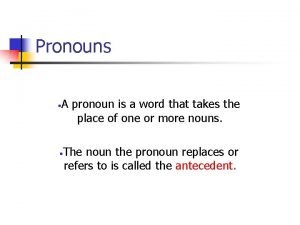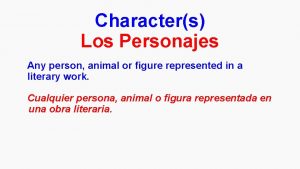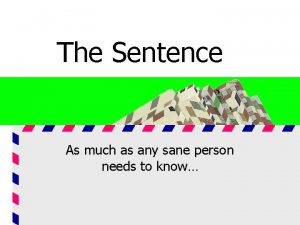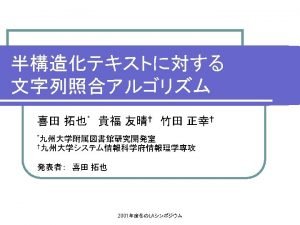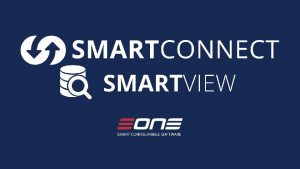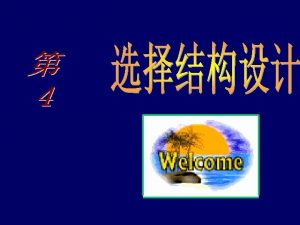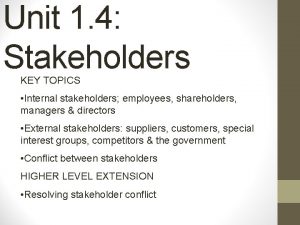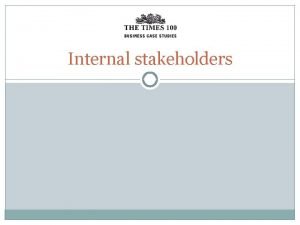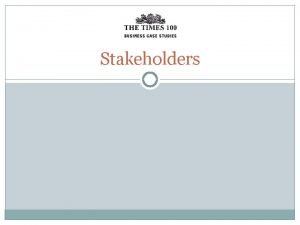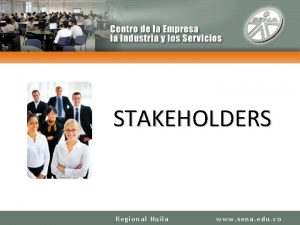Unit 1 4 Stakeholders Stakeholders Any person or
















- Slides: 16

Unit 1. 4 Stakeholders

Stakeholders • Any person or organization that has a direct interest in and is affected by the performance of a business • Internal Stakeholders – members of the organization (employees, shareholders, managers and directors) • External Stakeholders – do not form part of the business but have a direct interest or involvement in the actions of the organization (customers, suppliers and the government)

Owners Employees Customers Managers Business Suppliers Gov’t. Rivals Investors STAKEHOLDERS OF AN ORGANIZATION

Internal Stakeholders • Employees • Shareholders • Managers • Directors

External Stakeholders • Suppliers • Customers • Competitors • Pressure groups • Government

Pressure Groups – Consists of individuals with a common interest who seek to place demands on organizations to act in a particular way or influence a change in their behavior – Greenpeace, groups campaigning against smoking, deforestation and the harmful treatment of animals

Stakeholder Conflict • Different stakeholder groups have varying interests in an organization. • Conflict arises because the business cannot necessarily meet the need of all its stakeholders simultaneously. • Major cause of potential stakeholder conflict is the pay and remuneration of the directors of a company. • Stakeholders have more than one interest in an organization, therefore, different objectives.

Resolving Stakeholder Conflict • Leaders need to look at 3 key issues: –The type of organization in question –The aims and objectives of the business –The source and degree of power (influence) of each stakeholder

Read organization objectives and the CUEGIS concepts Pages 53 -54

Key Terms REVIEW

Conflict • Refers to situations where stakeholders have disagreements on certain matters due to differences in their opinions. This can lead to arguments and tension between the various stakeholder groups.

External Stakeholders • Are individuals and organizations not part of the organization but have a direct interest in its activities and performance, e. g. customers, suppliers, pressure groups and the government.

Internal Stakeholders • Are members of the organization, e. g. the employees, managers, directors and shareholders of the organization.

Pressure Groups • Consist of individuals with a common concern (such as environmental protection) who seek to place demands on organizations to act in a particular way or to influence a change in their behavior.

Shareholders (or stockholders) • Are the owners of a limited liability company. Shares in a company can be held by individuals and other organizations.

Stakeholders • Are individuals or organizations with a direct interest (known as a stake) in the activities and performance of a business, e. g. shareholders, employees, customers and suppliers.
 Was ist 2. person plural
Was ist 2. person plural Speak in 3rd person
Speak in 3rd person Person person = new person()
Person person = new person() First second and third person
First second and third person Some or any bananas
Some or any bananas Any to any connectivity
Any to any connectivity Seknder
Seknder Any person animal or figure represented in a literary work
Any person animal or figure represented in a literary work Example of a short paragraph using conjunctions
Example of a short paragraph using conjunctions Unit 6 review questions
Unit 6 review questions Formal and informal writing examples
Formal and informal writing examples First person vs third person writing
First person vs third person writing Person-job fit and person-organization fit
Person-job fit and person-organization fit Types of conflict in fahrenheit 451
Types of conflict in fahrenheit 451 Private string name java
Private string name java When a person is logrolled the person is
When a person is logrolled the person is Account
Account



